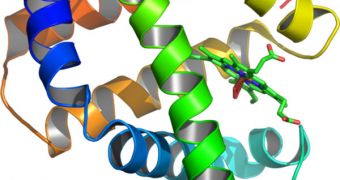In a groundbreaking new study, scientists at the University of Bristol, in the UK, managed to create the first ever, highly-concentrated liquid that does not contain water at all. The accomplishment was made possible only through the use of one of the blood's most important proteins, called myoglobin. This chemical gives blood and muscles their color, and is responsible for carrying iron when inside the cells. In the circulatory system, this task is carried out by the oxygen-binding protein hemoglobin. The recent study is extremely important, as it opens up new avenues of research in design and construction of new biomedical materials.
“To make a liquid myoglobin without adding water or any other solvent is really exciting, to find that the protein is still active in binding oxygen was astounding,” explained UB professor Stephen Mann, who carried out the investigation in collaboration with colleagues Dr Adam Perriman and Alex Brogan. All the researchers are based at the university's School of Chemistry. Details of their impressive work are published in the latest issue of the highly-regarded scientific journal Nature Chemistry. The most impressive aspect of the new liquid is that the proteins it contains retain their ability to reversibly bind oxygen.
It was additionally found that modifying the pressure applied on the liquid can influence the “potency” of the oxygen molecules inside the myoglobin. The UB team described the stuff as a very simple form or artificial blood, which means that applications such as in medical dressings and barrier films – to be applied to wounds – are conceivably possible in the near future. In addition to the creation of the new liquid itself, the work also carried broader implications. Scientists have for a long time believed that proteins require water molecules to operate correctly, and to maintain their structure and properties.
The recent work proved this to be false, and now microbiologists may need to assess their understanding of human proteins. “By using a chemical procedure in which surfactant molecules, a form of wetting agent, are attached to the protein surface, the researchers remove the water by freeze-drying at low temperature to produce a solid powder. When warmed to room temperature, the powder melts to produce a viscous liquid that contains a very high concentration of myoglobin molecules, while the protein structure remains unchanged even though no water is present,” the UB group writes in a press release on the university's website.

 14 DAY TRIAL //
14 DAY TRIAL //